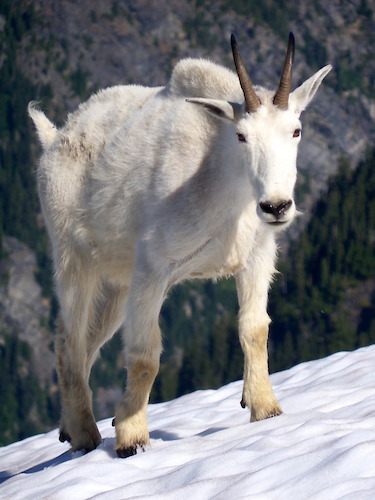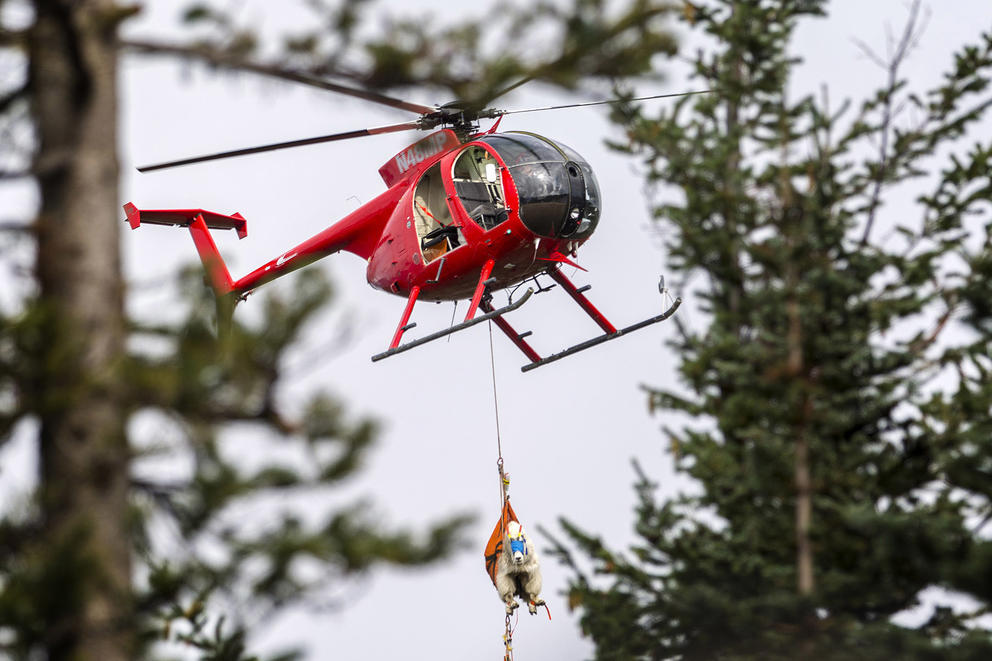With more than 2 million acres of protected public land in Washington’s North Cascades mountains, it is sobering to consider that two of the area’s signature mammals, mountain goats and grizzly bears, are largely absent from the landscape, victims of hunting and habitat loss. Fortunately, that may be about to change.
The first step involves the goats. Encountering shaggy, somber-faced mountain goats in Washington’s alpine country is, potential danger aside, a hiker’s delight. In the Cascades, historical populations totaling perhaps 10,000 goats have fallen dramatically to between 2,400 and 3,200. About 725 goats live on the Olympic Peninsula, where they were introduced for hunting in the 1920s.
The goats thrive in the fragile alpine ecosystems of the Olympic mountains, where they cause soil erosion and plant damage. They need salt from mineral outcroppings to survive, but no such areas exist in the Olympics. Instead, the animals get salt from human sweat and urine left by hikers and backpackers along trails. The goats have lost their fear of people and become more aggressive, culminating in the 2010 goring death of a hiker in Olympic National Park. Concerns about public safety and ecosystem management prompted the National Park Service, U.S. Forest Service, and Washington state Department of Fish and Wildlife to develop a plan to remove the goats from the Olympic Peninsula.
Under the plan, the agencies are moving several hundred goats to their historic native habitat in the Cascade mountains. The first phase began last month with some of the Olympic goats helicoptered and trucked to the North Cascades, and there will be another two-week period of moves in September 2019. That will bring about half the Olympic's goat population to the Cascades; the remainder will eventually be, in bureaucratic parlance, “lethally removed.”

The benefits to the North Cascades will be immediate. In one helicopter ride, goats are transformed from invaders to natives. They are needed in the Cascades, where goat herds have become small and isolated, leading to decreased genetic diversity and increased disease susceptibility. The influx of several hundred new goats will improve the animal’s long-term survival prospects.
Video of blindfolded, tranquilized mountain goats hanging in slings from helicopters is riveting. Watching them bound out of their carriers and up the steep slopes of the North Cascades — there are about a dozen sites in the Mount Baker-Snoqualmie and Okanogan-Wenatchee national forests — one can’t help but feel that the goats are home at last.
In contrast, grizzly bears are likely to have a more difficult comeback. The last confirmed sighting of a grizzly in the North Cascades was more than 20 years ago. Even if a few have managed to hang on, scientists say there are not enough to repopulate the area without help. To bring grizzlies back to the North Cascades, the largest potential habitat in the contiguous U.S., new bears must be imported. In January 2017, the National Park Service and U.S. Fish and Wildlife Service released a draft environmental impact statement outlining four options for restoring the grizzly, from doing nothing to adding bears over a number of years to reach a sustainable population of 200 animals by century’s end.
After unexpectedly halting the grizzly restoration process in December 2017, Interior Secretary Ryan Zinke visited the North Cascades National Park Headquarters in Sedro-Woolley this March to announce his support for bringing back the grizzly. Local bear advocates were surprised and cautiously optimistic that the EIS process would be allowed to continue. The federal agencies are expected to announce the preferred option by the end of this year.
While public opinion polls have shown strong support for restoring the grizzly, the reintroduction of a large carnivore to the North Cascades raises some concerns. Bear activity could temporarily close trails, diverting hikers, and ranchers whose land borders potential grizzly habitat worry about predation. Many people are simply afraid of grizzlies. Regardless of which restoration option is selected, a broad public education initiative is necessary if the grizzlies are to successfully repopulate the North Cascades.
The North Cascades constitute one of the most rugged, remote places remaining in the lower 48 states, and restoring two of its most elusive large mammals will enhance this spectacular wilderness. The prospect of seeing goats and grizzlies returned to their native habitat thrills many outdoors lovers. This month marks the 50th anniversary of North Cascades National Park. Let’s kick off the next 50 years of wilderness preservation by rewilding America’s Alps.


